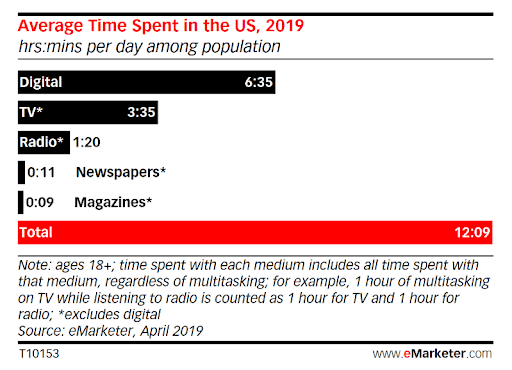According to the American economist Thomas Sowell; “The first lesson of economics is scarcity: there is never enough of anything to fully satisfy all those who want it.”
Once a unique proprietary product or service becomes commoditized it loses its scarcity in an over competing market-place and its distinct advantages become interchangeable with the products its rival offers. This leads to commodity-based pricing which results in much lower profit margins…
…sound familiar?
As an industry, we commoditized content first helped by the rise of technology and connected devices we’ve made content ubiquitous, available to anyone anywhere with an internet connection and what is scarce today is the supply of attention.
The second part of the digital publisher ecosystem to get commoditized was audience attention, by way of packaging up user page views, sessions times and clicks and selling them off to the lowest bidder.
This short-sighted drive for attention lead businesses to gamify their content to encourage more eyeballs and more clicks to feed their revenue models which Gideon Lichfield, Editor-in-chief at MIT Technology Review calls “Toxic and responsible for garbage content, fake news and the excessive power of giant social media platforms.” – not to mention the rise in click farms and digital ad-fraud.
The latest 2019 Time Spent with Media report from eMarketer suggests that on average Americans spend over twelve hours a day engaging with media. Drilling down into the report you’ll see that traditional newspapers and magazines present a worryingly low figure while digital makes up over half of their entire spent consuming content.
In a digital environment, it’s fair to say that every piece of content competes against all the others and competition is fierce. In a world with information surplus and attention scarcity this competition Tim Wu, Author of The Attention Merchants writes “will naturally run to the bottom: attention will almost invariably gravitate to the most garish, lurid, outrageous alternative, whatever stimulus may more likely engage our ‘automatic attention’.”
The problem is attention doesn’t scale and as Warren Buffet puts it. “Everybody has just got two eyeballs, and they’ve got X hours of discretionary time.”
A recent report from the Reuters Institute for the Study in Journalism found that of all the people surveyed across more than thirty countries 32% of respondents were actively avoiding the news. You could argue that as user engagement is in decline, that as a publisher you may find yourself in an attention recession and if that’s the case, how do you combat this to ensure economic stability and long-term sustainable growth.
If scarcity is the issue and the de-commoditization of attention the goal then how, as a publisher do you reverse this calamitous economic state.
The truth is you cannot turn the tide on an entire ecosystem levied so heavily on views and clicks over-night, but as an individual publisher, you can buck the trend and invest in a quality product, quality content and hold a longer term view when it comes to audience engagement.
1. Build on your Brand Equity
Public trust in media in 2018 was at an all time low – Edelman’s 2019 Trust Barometer shows nominal improvement YoY but still hovers around 60% of those people surveyed actually trust the content they consume from news sources.
With numerous factors to take into consideration, there’s no silver bullet for news outlets, and with their struggles further compounded by social media’s corrosive effect on the industry’s most uncompromising journalism, it’s a hard fought battle.
If you produce a vertical title however then your issue isn’t trust but competition, and for more popular hobby titles such as cooking and crafts these can run into hundreds of platforms and channels you compete against.
Even if your magazine has been around for fifty years and has no online presence, revisit your relationship with your audience. Focus on building positive brand equity and review in detail the public’s valuation of your brand.
Your goal is to develop a deep emotional connection with your audience and offer them a safe, comfortable environment filled with content that has a TOV which speaks to them.
2. Scale vs. Retention
For so long digital publishers have only been interested in chasing vanity metrics such as monthly active users (MAU) and page views (PV) because scale is the only thing advertisers are interested in seeing, but the landscape is changing.
CNN Digital International Vice President and Managing Editor Andrew Demaria says “We will see a trend in the digital media industry around the value of audiences, and being able to put a proper value on what that audience is.”
This means cultivating a relationship with your audience to drive higher levels of retention and reducing reliance on flyby referral traffic from social channels, understand who they are, don’t fall prey to clickbait and invest in producing quality content audiences want to consume and share.
3. Diversify Revenue to Avoid User Fatigue
When it comes to digital there was a time when you could just put another ad-unit on the page and increase revenues from existing traffic, but the rise in ad-blockers and freefall in the value of ad-impressions means the trade-off between revenue generated and user experience just isn’t worth the user fatigue and drop in brand equity. The same goes for sponsored mailers, branded content, events and merchandise…
Diversifying revenues is an opportunity to build new engagement mechanics with your audience and deepen your relationship with them, which some publishers have been very successful at. But don’t kid yourself, it’s unlikely you’ll pull off subscriptions without something very special.
Think laterally – you have all the information you need to generate revenue and if you’re still stuck you should get in touch with us.
I’ve been intentionally vague with my suggestions but the moral of the story is that to combat the attention recession and win hearts and minds you need to invest in a great platform, build on your brand equity, don’t view tech (ad-tech) as THE revenue driver it’s merely a means to an end to improve operational efficiency and most of all…
…Invest in content that moves people that is HEROIC, HELPFUL or HUMOROUS. Only by having great content can we decommoditise attention and provide audiences with something they want to trust, engage with and share. Ideas are easy. It’s the execution of ideas that really separates the sheep from the goats.








